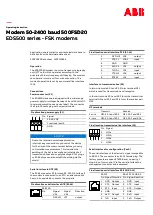
PSM-500/500L/500LT SCPC Satellite Modem
Maintenance
PSM-500/500L/500LT - Rev. 0.91
Page 4-3
and provide that signal to the BERT for synchronization. More information on using the PSM-
500’s internal BERT is given below.
4.1.2 Using the Built-in BERT
The PSM-500 contains a complete transmit and receive Bit Error Rate Test (BERT) set. Each
direction is independent and can be used for either loop-back testing or uni-directional testing
with another PSM-500 on the other end of the link. Since the test sequences used are industry
standard it should also be possible to use the built in BERT with an external BERT and any brand
of modem at the other link end, although this has not been extensively tested.
The Modulator (Transmit) BERT is enabled at
<Int’f: Test – Mod BER>
, and the Demodulator
(Receive) BERT is enabled at
< Int’f: Test – Dem BER >
. With either transmit or receive being
enabled by choosing either the 2047 or 2^23-1 test pattern options. Both should be the same to
operate properly.
When the Demodulator receive BER Test is enabled the test results are available in the
<Int’f:
Status - Test>
parameter item and the 7 items below it in the Interface Status column. These 7
items are:
1. Test BER – The ratio of errored bits to un-errored bits since the test began or was last
reset. Expressed in bits per bit as x.yyy E-power where the mantissa (x.yyy) is always
between 0 and 10 and power is the power of 10. For example 1.200 E-6 is 1.2 errored
bits in 10^6 bits, or 1.2 errors per million bits. No errors are expressed as 0.000E-power.
Since Errored bits do not accumulate during a sync loss, it is possible to lose sync for
several seconds and not have the BER affected.
2. Sync Loss – The total number of sync losses that have occurred since the test began or
was last reset.
3. Errors – The total number of bit errors that have occurred since the test began or was
last reset. Errored bits do not accumulate during a sync loss.
4. Bits – The total number of bits that have been received since the test began or was last
reset.
5. EFS – Error Free Seconds. The percentage of the total number of seconds with no errors
occurring during that particular second. Compiled since the test began or was last reset.
No errors are shown as “100.00%”. Errored seconds accumulate during a sync loss.
6. Erred Sec – The total number of seconds with errors occurring during that particular
second, since the test began or was last reset. Errored seconds accumulate during a
synch loss
7. Total Sec – The total number of seconds since the test began or was last reset.
The test is reset or started over by viewing any of the 7 status items listed above and pressing
the “Edit” or “0” key, then responding to the prompt “Enter to Restart” by pressing “Enter”. A
restart on any items resets all items and values.
A single error may be inserted when the BER test is active to verify proper operation by using the
<Int’f: Test – Mod BER>
parameter and pressing “3” and “Enter”. This could be useful since it is
sometimes difficult to see errors with the Turbo Product Codes FEC.
In the loop-back diagram shown above the BER test sets are physically between the satellite and
terrestrial loop-back functions. Thus data traversing through either of these loop-backs does not
involve the BER test sets, even if enabled. If the built-in BERT is being used the local “satellite
loop-back” function should not be enabled.
The transmit output from the built-in BERT always faces toward the modem’s transmit or satellite
side, while the receive comes from the modem’s receive side. It is not designed to transmit and
receive signals from the terrestrial side of the data connection.
















































